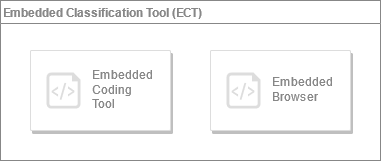Embedded Classification Tool (ECT)
What's new in version 1.7
Version 1.7 introduces new features:
New customizable settings
hierarchyResizable: for changing the width of the entities hierarchy using the mouse.otherPostcoordination: for enabling the “other postcoordination” area to build postcoordination expression using a wider set of classification entities.
The new settings above are both available for the Embedded Coding Tool and the Embedded Browser:
browserAdvancedSearchAvailable: for making available the advanced search function. Advanced search lets you search selected properties of the classification. You could search all properties or a selected subset only.browserHierarchyAvailable: for showing or hiding the entities hierarchy.includeDiagnosticCriteria: for including the Diagnostic Criteria (Diagnostic Requirements) into the browser content.
The new settings above are only for the Embedded Browser:
Improved multilingual support
The language setting is now an overwritable setting. It means the ECT library is able to manage multiple instances of Embedded Coding Tool and/or Embedded Browser in the same page that use different language (more info here)
ICF support
Version 1.7 now supports the International Classification of Functioning, Disability and Health (ICF) linearization (more info here)
Upgrade to version 1.7 is safe. There are no breaking changes moving from old versions 1.x to this version.
We highly recommend upgrading your current ECT to version 1.7
Overview
ICD-11 Coding Tool and ICD-11 Browser are web based softwares that helps users search, find and browse ICD-11 categories that they are looking for.
The Embedded Classification Tool (ECT) allows integration of a complete ICD-11 Coding Tool and/or ICD-11 Browser into any web application.

The Embedded Classification Tool (ECT) is written in Javascript for the complete compatibility with any web application and provides an easy way to give all the ICD-11 functionalities to your web applications.
Under the hood, it is powered by the ICD-API
Integrating the Embedded Classification Tool (ECT) is very easy. All you need to do is adding references to the provided javascript and css files and making minor modifications on your web page.
Installation
The Embedded Classification Tool (ECT) can be manually loaded from our CDN or installed via npm.
CDN
Include the stylesheet file icd11ect-1.7.css in the <head> section of your page.
<head>
<link rel="stylesheet" href="https://icdcdn.who.int/embeddedct/icd11ect-1.7.css">
</head>
Include the JavaScript file icd11ect-1.7.js before the closing </body> tag.
<script src="https://icdcdn.who.int/embeddedct/icd11ect-1.7.js"></script>
Try out the code playgrounds on the ECT samples page.
npm
Install the module via npm:
npm install @whoicd/icd11ect
After the installation, import the package and the stylesheet file:
import * as ECT from '@whoicd/icd11ect';
import '@whoicd/icd11ect/style.css';
Try out the code playgrounds on how to integrate ECT in Angular, React and Vue.js.
Documentation
The documentation offers a few ways to learn about the Embedded Classification Tool (ECT) library:
- Refer to the specific documentation of the Embedded Coding Tool.
- Refer to the specific documentation of the Embedded Browser.
- Then, read the Advanced settings documentation to learn more about it.
- Finally, try out the code playgrounds on the ECT samples page.